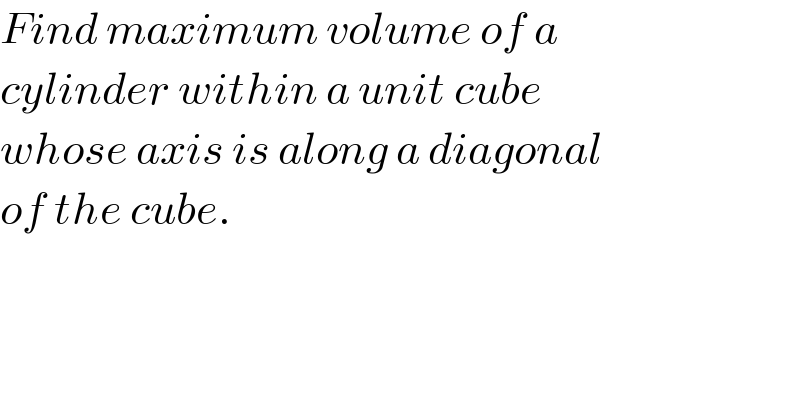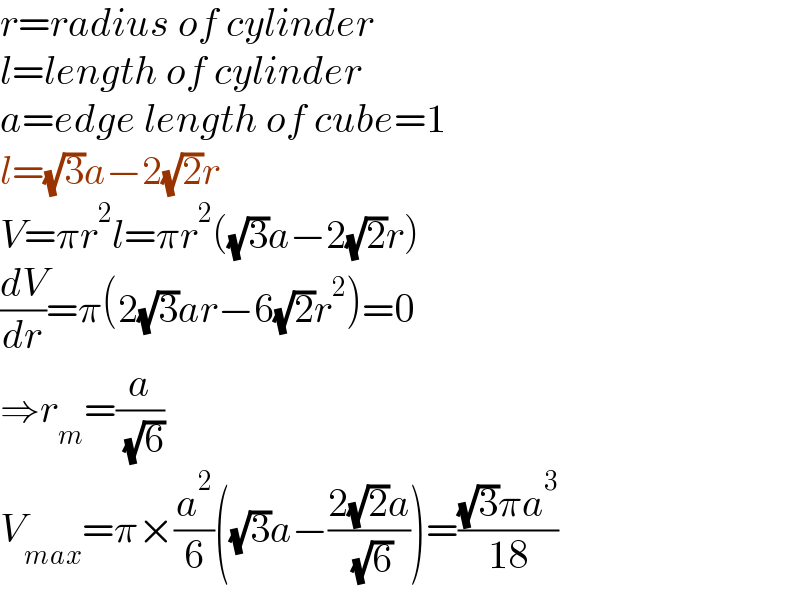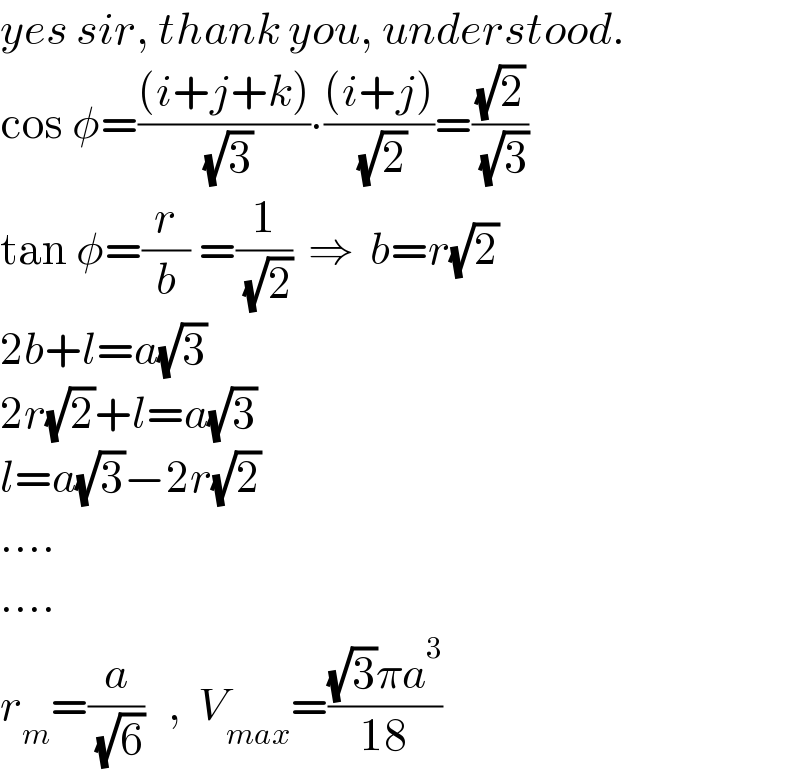
Question Number 138388 by ajfour last updated on 13/Apr/21

$${Find}\:{maximum}\:{volume}\:{of}\:{a} \\ $$$${cylinder}\:{within}\:{a}\:{unit}\:{cube}\: \\ $$$${whose}\:{axis}\:{is}\:{along}\:{a}\:{diagonal} \\ $$$${of}\:{the}\:{cube}. \\ $$
Answered by mr W last updated on 13/Apr/21

$${r}={radius}\:{of}\:{cylinder} \\ $$$${l}={length}\:{of}\:{cylinder} \\ $$$${a}={edge}\:{length}\:{of}\:{cube}=\mathrm{1} \\ $$$${l}=\sqrt{\mathrm{3}}{a}−\mathrm{2}\sqrt{\mathrm{2}}{r} \\ $$$${V}=\pi{r}^{\mathrm{2}} {l}=\pi{r}^{\mathrm{2}} \left(\sqrt{\mathrm{3}}{a}−\mathrm{2}\sqrt{\mathrm{2}}{r}\right) \\ $$$$\frac{{dV}}{{dr}}=\pi\left(\mathrm{2}\sqrt{\mathrm{3}}{ar}−\mathrm{6}\sqrt{\mathrm{2}}{r}^{\mathrm{2}} \right)=\mathrm{0} \\ $$$$\Rightarrow{r}_{{m}} =\frac{{a}}{\:\sqrt{\mathrm{6}}} \\ $$$${V}_{{max}} =\pi×\frac{{a}^{\mathrm{2}} }{\mathrm{6}}\left(\sqrt{\mathrm{3}}{a}−\frac{\mathrm{2}\sqrt{\mathrm{2}}{a}}{\:\sqrt{\mathrm{6}}}\right)=\frac{\sqrt{\mathrm{3}}\pi{a}^{\mathrm{3}} }{\mathrm{18}} \\ $$
Commented by mr W last updated on 13/Apr/21

$${fine}!\:{it}'{s}\:{more}\:{elegant}\:{using}\:{vectors}. \\ $$
Commented by ajfour last updated on 13/Apr/21

$${yes}\:{sir},\:{thank}\:{you},\:{understood}. \\ $$$$\mathrm{cos}\:\phi=\frac{\left({i}+{j}+{k}\right)}{\:\sqrt{\mathrm{3}}}\centerdot\frac{\left({i}+{j}\right)}{\:\sqrt{\mathrm{2}}}=\frac{\sqrt{\mathrm{2}}}{\:\sqrt{\mathrm{3}}} \\ $$$$\mathrm{tan}\:\phi=\frac{{r}}{{b}}\:=\frac{\mathrm{1}}{\:\sqrt{\mathrm{2}}}\:\:\Rightarrow\:\:{b}={r}\sqrt{\mathrm{2}} \\ $$$$\mathrm{2}{b}+{l}={a}\sqrt{\mathrm{3}} \\ $$$$\mathrm{2}{r}\sqrt{\mathrm{2}}+{l}={a}\sqrt{\mathrm{3}} \\ $$$${l}={a}\sqrt{\mathrm{3}}−\mathrm{2}{r}\sqrt{\mathrm{2}} \\ $$$$.... \\ $$$$.... \\ $$$${r}_{{m}} =\frac{{a}}{\:\sqrt{\mathrm{6}}}\:\:\:,\:\:{V}_{{max}} =\frac{\sqrt{\mathrm{3}}\pi{a}^{\mathrm{3}} }{\mathrm{18}} \\ $$
Commented by mr W last updated on 14/Apr/21

$${can}\:{you}\:{prove}\:{Q}\mathrm{138519}\:{using}\:{vector} \\ $$$${method}?\:\:{i}\:{found}\:{that}\:{by}\:{accident},\:{but} \\ $$$${have}\:{no}\:{proof}\:{yet}. \\ $$
Answered by mr W last updated on 14/Apr/21

